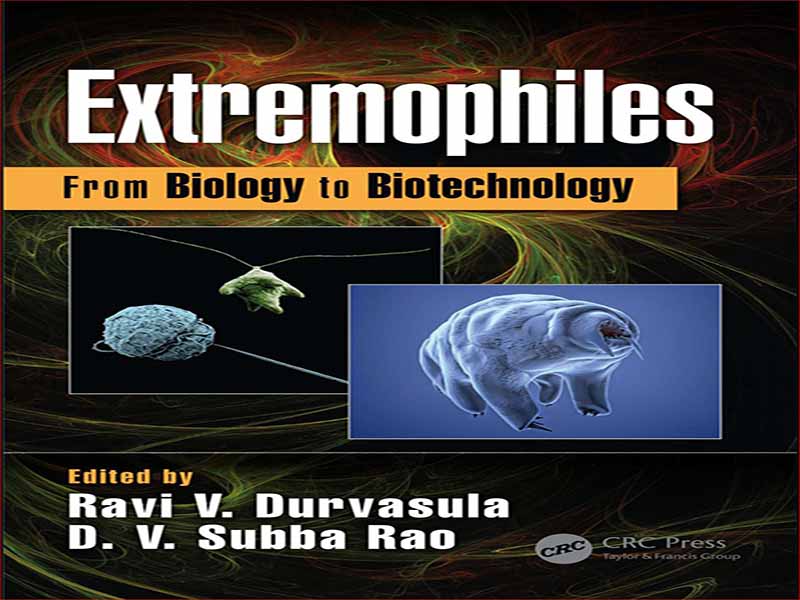- عنوان کتاب: Extremophiles From Biology to Biotechnology
- نویسنده: Ravi Durvasula
- حوزه: بیوتکنولوژی
- سال انتشار: 2018
- تعداد صفحه: 438
- زبان اصلی: انگلیسی
- نوع فایل: pdf
- حجم فایل: 8.91 مگابایت
رومیها از اصطلاح extremus برای توصیف چیزی خارج از هنجار استفاده میکردند، که مکالروی (1974) فیلوس را به آن ملحق کرد و اصطلاح extremophile را برای تعریف ارگانیسمها – از باکتریها تا ماهیها – ارائه کرد که در محیطهای شدید زندگی میکنند، از قطب جنوب یخزده تا دریچههای گرمابی داغ. . اکستروموفیل ها بازمانده های نهایی طبیعت هستند که در زیستگاه های چالش برانگیز تحت تنش های متعدد دما، نور، شوری و pH زندگی می کنند. نقل قول “آنچه ما را نمی کشد ما را قوی تر می کند” توسط فیلسوف آلمانی فردریش نیچه (1844-1900) برای افراد افراطی قابل استفاده است. مطالعات بر روی اکستروموفیل های آبزی از 21 مورد در سال 1997 به 494 مورد فعلی افزایش یافته است. به همین ترتیب، تعداد اکستروموفیل های شناسایی شده از همه زیستگاه ها از 279 به 2860 در همان دوره افزایش یافت. توصیف افراد افراطی، از جمله “میکروب هایی که تحت شرایطی رشد می کنند که موجودات دیگر را می کشند” (مادیگان و مار 1997)، “اکثریت نامرئی” (ویتمن و همکاران 1998)، “تخریب ناپذیر” (کاپلی 1999)، “بازمانده های افراطی نهایی” (Rothschild and Mancinelli 2001)، «میکروبهای منحصربهفرد که در محیطهای منحصربهفرد یافت میشوند» (Brock 2012)، و «میکروبهای سخت مولکولهای سخت تولید میکنند» (Anitori 2012)، بیشترین تأثیر را بر ما برای گردآوری این مجموعه گذاشتند. مطالعه قبلی بر روی هالوفیل های Chlamydomonas plethora و Nitzschia frustule، جدا شده از خلیج کویت، خلیج عربی (Subba Rao et al. 2005) و مطالعات جدیدتر بر روی یک ریزجلبک گرمادوست، گونه Scenedesmus، از سد سودا، نیومکزیکو (Durvasulaet) 2015) انگیزه پشت این کتاب بوده است. ما از دو انتشارات جدیدتر در Nature (هاشیموتو و همکاران 2016؛ Bittel 2016) در مورد پروتئینهای یک Tardigrade بسیار متحمل الهام گرفتهایم که به DNA انسان کمک میکند تا در برابر تشعشعات مقاومت کند، و ما را به این فکر میکند که «جایی، چیزی باورنکردنی در انتظار شناخته شدن است». منسوب به کارل ساگان). کشف جوامع میکروبی غنی خاک تحت سلطه Actinobacteria، Chloroflexi، Proteobacteria، Acidobacteria، و دو فیلا جدید AD3 و WPS-2 توسط تیم دکتر Belinda C. Ferrari در وسعت یخ زده قطب جنوب است. این جوامع به طور هوازی H2 و CO اتمسفر را با نرخ های کافی برای تامین منابع انرژی و کربن برای حمایت از عملکرد اکوسیستم خود حذف کردند (Ji et al. 2017). این یافته خیرهکننده «امکان وجود گازهای جوی را برای حیات در سیارات دیگر باز میکند». این کتاب مروری بر تحولات اخیر و مؤلفههای درک کنونی افراد افراطی ارائه میکند. ما عمداً از مطالعات طبقهبندی توصیفی این موجودات زنده دوری کردهایم. درک اکستروموفیل ها و کاربرد آنها در بیوتکنولوژی شامل مطالعه زیستگاه آنها و سازگاری های فیزیولوژیکی و بیوشیمیایی آنها است. مکانیسمهای تولید بیوکاتالیستهایی که در شرایط شدید عملکردی دارند تا حد زیادی ناشناخته باقی ماندهاند. انبوهی غیرقابل تصور از حیات میکروبی با مقدار خارقالعادهای از تنوع ژنتیکی، بهویژه Archaea وجود دارد.
The Romans used the term extremus to describe something outside the norm, to which MacElroy (1974) conjoined philos and offered the term extremophile to define organisms—from bacteria to fishes—that inhabit extreme environments, ranging from the frozen Antarctic to abyssal hot hydrothermal vents. Extremophiles are nature’s ultimate extreme survivors that live in challenging habitats under multiple stresses of temperature, light, salinity, and pH. The quote “That which does not kill us makes us stronger” by the German philosopher Friedrich Nietzsche (1844–1900) is applicable to extremophiles. Studies on aquatic extremophiles have increased exponentially from 21 in 1997 to the current 494; likewise, the numbers of identified extremophiles from all habitats increased from 279 to 2860 in the same period. Descriptions of extremophiles, including “microbes that thrive under conditions that would kill other creatures” (Madigan and Marr 1997), “the unseen majority” (Whitman et al. 1998), “the indestructible” (Copley 1999), “ultimate extreme survivors” (Rothschild and Mancinelli 2001), “unique microbes that are found in unique environments” (Brock 2012), and “tough microbes produce tough molecules” (Anitori 2012), influenced us most to compile this collection. An earlier study on the halophiles Chlamydomonas plethora and Nitzschia frustule, isolated from Kuwait Bay, Arabian Gulf (Subba Rao et al. 2005), and more recent studies on a thermophile microalga, Scenedesmus species, from Soda Dam, New Mexico (Durvasula et al. 2015) have been the motivation behind this book. We are inspired by two more recent publications in Nature (Hashimoto et al. 2016; Bittel 2016) on proteins from an extremotolerant Tardigrade that help human DNA withstand radiation, leading us to think, “Somewhere, something incredible is waiting to be known” (credited to Carl Sagan). Of interest is the discovery of rich soil microbial communities dominated by Actinobacteria, Chloroflexi, Proteobacteria, Acidobacteria, and two new phyla AD3 and WPS-2 by Dr. Belinda C. Ferrari’s team in the frozen expanses of Antarctica. These communities aerobically scavenged atmospheric H2 and CO at rates sufficient to provide sources of energy and carbon to support their ecosystem functioning (Ji et al. 2017). This stunning finding “opens up the possibility of atmospheric gases supporting life on other planets.” This book presents an overview of the recent developments and components of the current understanding of extremophiles. Deliberately, we have steered away from descriptive taxonomic studies of these biota. Understanding extremophiles and their utility in biotechnology involves studying their habitat and their physiological and biochemical adaptations. Mechanisms for the production of biocatalysts that are functional under extreme conditions remain largely unknown. There is an unimagined profusion of microbial life with an extraordinary amount of genetic diversity, particularly the Archaea.
این کتاب را میتوانید بصورت رایگان از لینک زیر دانلود نمایید.




































نظرات کاربران